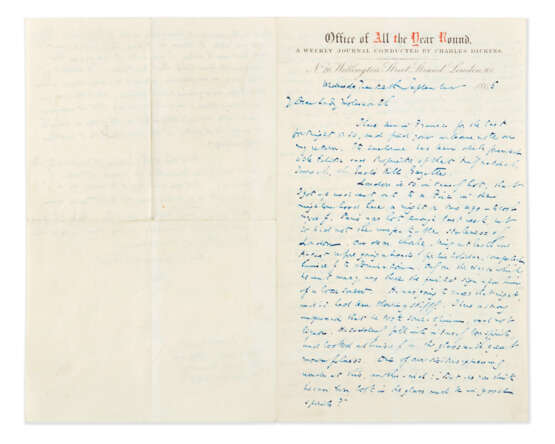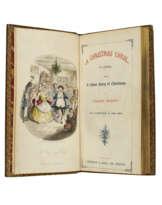ID 993251
Lot 77 | DICKENS, Charles (1812-1870).
Valeur estimée
£ 14 000 – 18 000
Autograph letter signed (with flourished initials, ‘C.D.’) to Lady Molesworth, Office of All the Year Round, 26 Wellington Street, London, 20 September 1865.
Closely written in blue ink on 3 pages, 203 x 127mm, bifolium, on paper with printed heading of ‘Office of All the Year Round’. Provenance: by descent from the recipient; Pencarrow sale, Sotheby's, 8 December 1999, lot 21; Sotheby's, 12 July 2006, lot 68.
A remarkable letter combining sparkling humour with an admission of the continuing post-traumatic effects of the Staplehurst rail crash. Dickens begins with a frivolous reference to the hot weather: 'London is so intensely hot, that I got up and went out to a Fire in the neighbourhood here a night or two ago – to cool myself. Paris was hot enough last week, but it had not the unspeakable staleness of London'. The music critic (and alcoholic) Henry Chorley has been visiting Gad's Hill, where he 'comported himself to admiration. Only on the day on which he went away, was there the faintest sign upon him of a loose screw. ... I have a strong impression that he took some opium, and not liquor. He suddenly fell into intensely low spirits, and looked at himself in the glass with great mournfulness. One of our visitors expressing wonder at this, another said: – “But do you think he can ever look in the glass and be in good spirits?”'. On his recent visit to Paris, Dickens reports that all his efforts to visit the theatre or opera were thwarted by the intense heat. Having devoted a full paragraph to news of the dogs at Gad's Hill, Dickens only in his last paragraph addresses the continuing effect on him of the Staplehurst rail disaster three months previously: 'My report of myself is – All right. I had a touch of Neuralgia all through August (I almost always have when I am hard at work), but I got rid of it within a few hours of crossing from Folkestone. That Railway accident occurred on the 9th. of June. I have not been able to bear an Express Train since, until this last week, when I was able to conquer the disagreeable sensations that beset me. The oddest of these, was, an impression, against my own senses and knowledge and against all reason, that the carriage was turning over; and it is curious that it invariably seemed to be turning over, – not on the side on which it really did pitch in the accident, but on the other side'.
Andalusia Molesworth, Lady Molesworth (c.1809-1888) overcame humble origins and an early career as an opera singer to become one of the most brilliant society hostesses of her age. While the early part of Dickens's letter clearly responds to her sparkling personality, the change in tone in its last paragraph reflects the deep imprint on him left by the Staplehurst rail crash three months previously: this occurred when the boat train from Folkestone, on which Dickens was travelling with his mistress, Ellen Ternan, and her mother after a visit to Paris, derailed on a viaduct, killing ten passengers and injuring forty: 'Dickens himself was unhurt but very badly shaken, not only by the accident itself but also by the experience of working for hours afterwards among the injured and the dying and trying to alleviate their sufferings, mainly by administering brandy to them from the bottle and a half which "by an extraordinary chance" he happened to have with him' (ODNB). The effects stayed with him for the rest of his life, and he died five years to the day after the accident.
Published in the online Charles Dickens Letters Project.
Special notice
This lot has been imported from outside of the UK for sale and placed under the Temporary Admission regime. Import VAT is payable at 5% on the hammer price. VAT at 20% will be added to the buyer’s premium but will not be shown separately on our invoice.
| Artiste: | Charles Dickens (1812 - 1870) |
|---|---|
| Lieu d'origine: | Europe du Nord, Europe, Royaume-Uni |
| Catégorie maison de vente aux enchères: | Lettres, documents et manuscrits |
| Artiste: | Charles Dickens (1812 - 1870) |
|---|---|
| Lieu d'origine: | Europe du Nord, Europe, Royaume-Uni |
| Catégorie maison de vente aux enchères: | Lettres, documents et manuscrits |
| Adresse de l'enchère |
CHRISTIE'S 8 King Street, St. James's SW1Y 6QT London Royaume-Uni | |
|---|---|---|
| Aperçu |
| |
| Téléphone | +44 (0)20 7839 9060 | |
| Commission | see on Website | |
| Conditions d'utilisation | Conditions d'utilisation |













